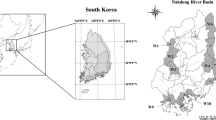Abstract
Drought problems must be analyzed and solved at a regional level. Drought studies must focus not only on the hydrological characterization of the phenomena but also formulate the results in terms of engineering risk. In this paper concepts and methods to characterize droughts as regional processes are presented. The concepts of risk, reliability, resiliency and vulnerability are applied to characterize regional droughts and provide an engineering framework to deal with drought problems. A Portuguese river basin (rio Ave) is used to illustrate the concepts and techniques presented in the paper. A multivariate stochastic model is used to generate a synthetic series of monthly precipitation at six distinct regions defined in the river basin. Thirty-three years of monthly data are used to calibrate the parameters of this model. The generated series is used to perform the study of regional droughts from an engineering risk point of view.
Access this chapter
Tax calculation will be finalised at checkout
Purchases are for personal use only
Preview
Unable to display preview. Download preview PDF.
Similar content being viewed by others
References
Abreu, A. (1985 in preparation) Caracterizaçao Geral da Bacia Hidrografica do Rio Ave (General Characterization of the River Ave Watershed). Lisboa, Laboratdrio Nacional den Engenharia Civil
Chow, V.T. (ed.) (1964) Handbook of Applied Hydrology. New York, McGraw Hill Book Co.
Duckstein, L. and E. Plate (1983) A System Framework for Hydrological Reliability with Application to the Design of Structures. Proceedings of the Hamburg Symposium, International Association of Hydrologie Sciences.
Duckstein, L., E. Plate and M. Benedini (1984) Incidents and Failures in Reservoirs and Dams: A Mathematical System Framework. Fall Meeting, American Geophysical Union.
Gibbs, W. and J. Maher (1967) Rainfall Deciles as Drought Indicators. Bulletin No. 48, Melbourne, Bureau of Meterology.
Hashimoto, T. (1980) Robustness, Reliability, Resilience and Vulnerability Criteria for Planning Water Resources Systems. Ph.D. Thesis, Ithaca, New York, Cornell University.
Hashimoto, T., J. Stedinger and D. Loucks (1982) Reliability, Resiliency and Vulnerability Criteria for Water Resource System Performance Evaluation. Water Resources Research, Vol. 18, No. 1, American Geophysical Union.
Lang, R. (1915) Versuch einer exakten Klassifikation der Boden in klimatischer und geologischer Hinsicht (a Proposed Exact Classification of Soils from the Climatic and Geological Viewpoints). Internat’l Mittlg. Fur Bodenkunde, Vol. 5.
Martonne, E. (1926) Une Nouvelle Fonction Climatologique: L’Indice d’Aridité (A New Climatological Function: The Aridity Index). Meteorologie, Vol. 2, Paris.
Palmer, W. (1965) Meteorological Drought. Paper No, 45, Washington D.C., U.S. Department of Commerce, Weather Bureau Research.
Rodrigues, R. and F. Correia (1985 in preparation) Caterizaçao do Regime de Preciptaçôes da Bacia Hidrografica do Rio Ave (General Characterization of the Precipitation Regime of the River Ave Watershed). Lisboa, Laboratdrio Nacional de Engenharia Civil.
Sancho, C. and D. Arias (1978) Analisis de las Sequias en Mexico (Analysis of Droughts in Mexico). Ciudad de Mexico, Comissión del Plan Nacional Hidraulico.
Santos, M. (1981) On the Stochastic Characterization of Regional Droughts. Research Officer Thesis. Lisboa, Laboratdrio Nacional de Engenharia Civil.
Santos, M. (1983) Regional Droughts: A Stochastic Characterization. Journal of Hydrology No. 66. Amsterdam, Elsevier Science Publishers.
Santos, M., F. Correia, and L. da Cunha (1984) Drought Characterization and Impact Assessment, Case Study of Portugal, in Coping with Droughts, Edited by Yevjevich, V., L. da Cunha and E. Vlachos, Littleton, Water Resources Publications.
Thornthwaite, C. (1948) An Approach Toward a Rational Classification of Climate. Geographic Review, Vol. 38.
WMO (1975) Drought. Special Environment Report No. 5, Geneva, Secretariat of the World Meteorological Organization.
Author information
Authors and Affiliations
Editor information
Editors and Affiliations
Rights and permissions
Copyright information
© 1987 Martinus Nijhoff Publishers, Dordrecht
About this chapter
Cite this chapter
Correia, F.N., Santos, M.A., Rodrigues, R.R. (1987). Engineering Risk in Regional Drought Studies. In: Duckstein, L., Plate, E.J. (eds) Engineering Reliability and Risk in Water Resources. NATO ASI Series, vol 124. Springer, Dordrecht. https://doi.org/10.1007/978-94-009-3577-8_4
Download citation
DOI: https://doi.org/10.1007/978-94-009-3577-8_4
Publisher Name: Springer, Dordrecht
Print ISBN: 978-94-010-8100-9
Online ISBN: 978-94-009-3577-8
eBook Packages: Springer Book Archive




